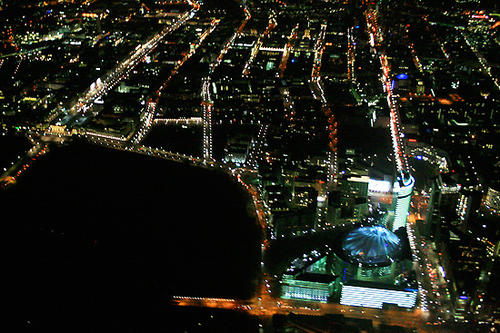Brightly Lit Nights, Smog, and Lurking Dangers
Researchers examine climatic and environmental influences on big city residents.
Apr 23, 2010
Many spots in Berlin are bright day and night: Light pollution brings confusion to the biorhythm of humans and animals. Above: Potsdamer Platz, Leipziger St. (r.), Tiergarten park (l.)
Image Credit: Freie Universität Berlin / Institut für Weltraumwissenschaften
The project’s six subprojects deal with greenhouse gases, air quality, light pollution, water management, tick-borne pathogens, and human health under changing environmental conditions. The aim is to develop a three-dimensional computer model of a city based on Berlin as an example that can be used to show how climate change affects human health and how possible negative influences can be minimized.
To see how temperature and other environmental factors affect the human body, the “Climate Change and Human Health” subproject has already sent six test subjects on different paths through Berlin. Attached to each subject’s body were sensors that measured his or her heart rate and body temperature, along with the exterior temperature, wind speed, humidity, and air pollution in Berlin.
In “The Dark Side of Light Pollution,” a team of researchers including meteorologists, medical scientists, biologists, and urban planners is looking at the harmful effects of light pollution. Physicists measure the nighttime light spectrum from the ground and from the air, and biologists study the negative effects of light on the ecosystem.
The “Vector-borne Diseases in an Urban Environment” subproject focuses on ticks and the pathogens they transmit. This research project is collecting data that should show what environmental factors make specific areas in the city especially attractive to ticks and their hosts.
Sustainable water management for urban areas is the focus of the “Sustainable Water Management, Land Use and Ecology” subproject. The researchers aim to use the results of the research performed in the project to develop a roadmap for land use and water management in the capital city area of Berlin and Brandenburg that takes climate change and changing environmental factors into account.
“Air Quality in Cities” is the name of another subproject; it is examining the influence of climate change on air quality in major urban areas, with a focus on particulate matter, ozone, and nitrogen oxides. Project researchers aim to use various measurement data to simulate how air pollution affects urban residents.
In the “Greenhouse Gases in Berlin” subproject, researchers aim to develop a carbon cycle model that shows Berlin’s greenhouse gas footprint. This should help them determine which parameters need to be changed in order to optimize Berlin’s greenhouse gas emissions.

